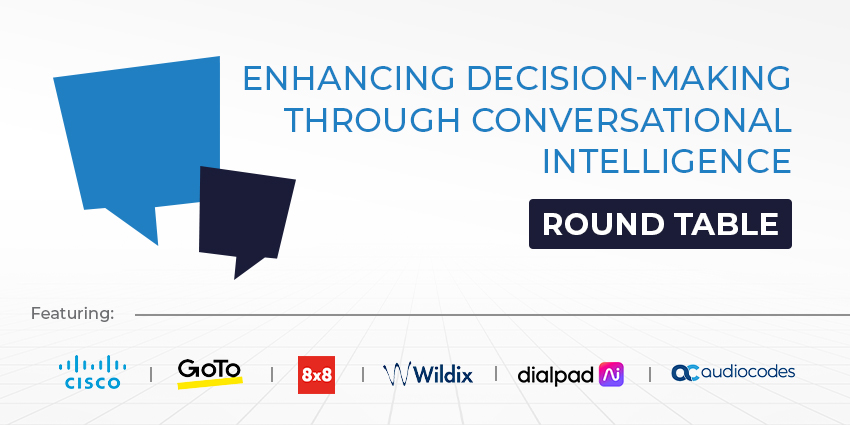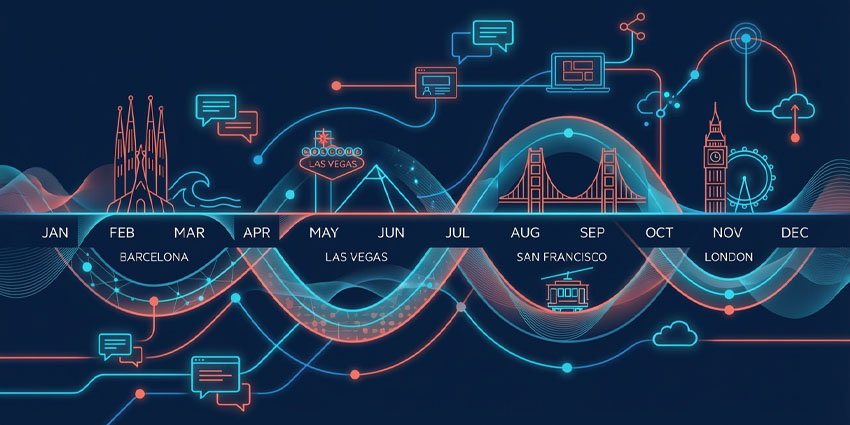The enterprise world is experiencing a fundamental shift in how organizations process information and make decisions. AI has brought in unprecedented capacities with text-based analytics, and while valuable, companies are beginning to understand that the information gained from this is only scratching the surface.
Forward-looking companies are beginning to imagine what’s possible when they tap into the rich context of human conversation. Conversational intelligence represents a quantum leap forward, moving beyond static data to capture the nuances of tone, sentiment, and intent that drive real business outcomes.
This technology stands to transform every customer interaction, team meeting, and strategic discussion into actionable intelligence that can reshape how organizations operate and compete.
Yet with this transformative potential comes significant challenges. Organizations must navigate complex integration requirements, cultural resistance, data privacy concerns, and the need to ensure that insights translate into measurable business results. The key lies not just in adopting conversational intelligence, but in implementing it strategically.
For our latest UC Round Table topic, “Enhancing Decision-Making Through Conversational Intelligence,” we spoke with experts and executives from Cisco, GoTo, 8×8, Wildix, Dialpad, and AudioCodes about the transformative potential of conversational intelligence, the barriers to successful adoption, the critical importance of data governance, and the emerging trends that will define the next phase of intelligent communication.
- Conversational Intelligence Compliance: How CI Strengthens Compliance Strategies
- Conversational Intelligence: Why CI is Crucial to your 2025 UC Strategy
What does the advance in conversational intelligence stand to bring decision-making beyond what text-based intelligence could?
The evolution from text-based to conversational intelligence represents more than a technological upgrade—it’s a fundamental reimagining of how organizations capture and act on the wealth of information embedded in human communication. While text analytics focus on explicit content, conversational intelligence reveals the complete story, including emotional context, urgency, and intent that traditional systems miss entirely.
Snorre Kjesbu, SVP & GM of Collaboration, Employee Experience Technology, Cisco

Kjesbu emphasizes that conversational intelligence transforms decision-making by analyzing the complete context of human interaction, not just words. This comprehensive approach enables organizations to make decisions that are both informed and empathetic, moving beyond simple data retrieval to genuine understanding of people and their needs.
“Conversational intelligence takes employees’ decision-making to a new level by analyzing not just words, but the full context of human interaction including tone, sentiment, and intent. Unlike text-based intelligence, conversational intelligence captures the subtleties of verbal communication, enabling more nuanced insights into team dynamics, customer sentiment, and decision-making processes.”
Simon Perreault, Vice President of Shared Technology Innovation Group, GoTo
Perreault highlights how generative AI has liberated conversational intelligence from the rigid constraints of early rule-based systems. This evolution enables platforms to handle diverse scenarios with human-like adaptability, drawing on extensive training data to make nuanced decisions in real-time.
“Generative AI advances have fuelled a genuinely transformational leap forward. Instead of being restricted to rigid ‘if this, then that’ protocols, the foundation models powering conversational offerings are now shaped by massive stores of both unstructured and structured data. As a result, systems have significantly improved capacity to manage diverse customer queries and scenarios, drawing on extensive training insights to determine their best next step and adapt to evolving needs on the fly.”
Jonathan Mckenzie, Contact Centre AI Expert, 8×8
Mckenzie describes how conversational intelligence enables proactive customer service through real-time analysis of pain points and sentiment, transforming unified communications from

reactive to predictive systems that enhance overall customer experience.
“There is transformative and innovative potential of conversational intelligence in enhancing unified communications. A good platform leverages AI and NLP, which enables real-time sentiment analysis, identification of customer pain points, and optimisation of agent performance. By adding conversational intelligence into UC solutions, we can proactively address customer needs, reduce churn, and inform product development.”
Steve Osler, CEO, Wildix
Osler positions conversational intelligence as the bridge between knowing what happened and knowing what to do next. His emphasis on real-time action and intent recognition demonstrates how this technology enables frontline teams to respond instantly to changing conditions without traditional delays.
“Conversational intelligence is the difference between knowing what happened and knowing what to do next. It doesn’t just transcribe words, it picks up tone, urgency, and intent in real time. That means faster decisions, better timing, and fewer things slipping through the cracks. With tools like x-hoppers that have ChatGPT integration, video and speech recognition, and real-time analytics frontline teams can act instantly, flagging restocks, reporting theft, or surfacing promotions, just by speaking.”
Jim Palmer, Chief AI Officer, Dialpad
Palmer reveals how conversational intelligence unlocks previously inaccessible data assets, transforming routine interactions into strategic business intelligence. This shift from static reporting to dynamic insights enables organizations to identify opportunities and coaching moments as they happen.
“For years, businesses have been sitting on their most valuable data asset without even knowing it. Every customer support call, sales conversation, and client interaction contains rich contextual data that has remained largely inaccessible until now. While text-based intelligence captures explicit responses, voice reveals the full story: not just what customers say, but how they really feel about it.”
Andy Elliot, Director of Corporate Marketing, AudioCodes
Elliot emphasizes voice as the most fundamental form of human communication, positioning conversational intelligence as inherently more powerful than text-based alternatives. His examples demonstrate how this technology creates more natural customer experiences while extracting valuable insights from every interaction.
“Voice remains the most fundamental form of human communication, so conversational intelligence has more applications and is a more powerful tool than simple text-based intelligence. Conversational intelligence helps improve customer interaction by handling customer enquiries via voicebots, a far more natural experience than via text-based chatbots. Using AI, organisations can extract key data and valuable insights from every voice conversation, every meeting and every customer interaction.”
What are the most significant challenges in adopting conversational intelligence tools?
Despite the transformative potential of conversational intelligence, organizations face substantial hurdles in implementation. These challenges span technical complexity, cultural resistance, and the need for comprehensive integration across existing systems. Success requires addressing both technological and human factors that can make or break adoption efforts.
Snorre Kjesbu, SVP & GM of Collaboration, Employee Experience Technology, Cisco
Kjesbu identifies the human element as equally important as the technology itself. He emphasizes that successful adoption requires addressing data integration, user adoption, and accessibility challenges, particularly in hybrid work environments where technical infrastructure varies significantly.
“The journey to conversational intelligence is as much about people as it is about technology. Adopting conversational intelligence tools involves addressing challenges such as data integration, user adoption, and ensuring accessibility for all team members. Many organizations also face hurdles in scaling these tools effectively, especially in hybrid work environments where only a fraction of meeting spaces are video enabled.”
Simon Perreault, Vice President of Shared Technology Innovation Group, GoTo

Perreault notes that while implementation complexity has decreased significantly, new challenges have emerged around understanding and risk perception. He advocates for gradual implementation to build confidence and practical understanding across organizations.
“The newness of innovative tech can pose a problem in itself. Companies may worry that adapting existing systems for adoption will be beyond their capabilities because they don’t understand what’s involved. For example, our research has found that over eighty percent of global knowledge workers don’t feel well-versed in the practical uses of AI. The simplest way to address both these fears is to start small.”
Jonathan Mckenzie, Contact Centre AI Expert, 8×8
Mckenzie highlights the complexity of ensuring regulatory compliance while achieving seamless integration across fragmented systems. He emphasizes that technical challenges are compounded by cultural resistance and the need for effective training programs.
“Conversations normally begin around ensuring data privacy and regulatory compliance, particularly when handling sensitive customer interactions across global regions. Another thing seen as a challenge is the seamless integration into existing UC + CC environments is often hindered by fragmented platforms and legacy systems. And you cannot rule out or underestimate cultural resistance and low user adoption frequently emerge when frontline teams are not effectively onboarded or shown clear value.”
Steve Osler, CEO, Wildix

Osler identifies three critical areas: defining clear objectives, achieving integration at scale, and fostering cultural adoption. He stresses that success depends on having specific, measurable goals rather than vague aspirations for improvement.
“I see three primary issues: defining clear objectives, integration at scale, and cultural adoption. Start with intent. Too many teams dive in without knowing what they’re solving for. ‘Let’s improve customer experience’ sounds nice, but what does that mean? Faster support? Shorter queues? Fewer dropped calls? Be specific, or you’ll end up with insights no one knows what to do with.”
Jim Palmer, Chief AI Officer, Dialpad
Palmer describes integration complexity as the primary challenge, where fragmented systems create puzzle-like scenarios that become increasingly difficult to solve at scale. He emphasizes how data quality issues compound these problems, particularly in high-volume environments.
“The biggest headache is integration complexity. Most companies have their phone system in one place, CRM somewhere else, and email platform over here, and they’re trying to extract intelligence from this mess. It’s like trying to solve a puzzle when half the pieces are in different rooms. Then there’s the data quality problem. You can have the most sophisticated AI in the world, but if you’re feeding it noisy audio, incomplete transcripts, or conversations missing critical context, you’ll get garbage insights.”
Andy Elliot, Director of Corporate Marketing, AudioCodes
Elliot focuses on the complexity of navigating diverse technology choices and the critical importance of security in voice communications. He also addresses the human challenge of positioning conversational intelligence as a productivity tool rather than surveillance.
“Navigating the maze of choices when it comes to AI, language models, different bot frameworks, and the convergence of UCaaS and CCaaS. Voice—and therefore conversational intelligence—is at the core of all of this, it’s business critical, and it has to be secure. There is also a people challenge—the need to persuade employees that conversational intelligence is not a ‘big brother’ analysing their conversations, but is in fact a great tool that, when applied properly, will make them more productive and will help them do their job better.”
How can organizations ensure the insights generated from conversational analytics are actionable and lead to measurable business outcomes?
Converting conversational intelligence insights into tangible business results requires more than sophisticated technology—it demands strategic integration into workflows, clear measurement frameworks, and a commitment to turning data into action. Organizations must bridge the gap between insight generation and practical application to realize meaningful return on investment.
Snorre Kjesbu, SVP & GM of Collaboration, Employee Experience Technology, Cisco
Kjesbu emphasizes that insights are only valuable when they inspire action. His approach focuses on embedding conversational intelligence into everyday processes, enabling teams to act on insights immediately rather than waiting for post-meeting analysis.
“Insights are only as valuable as the actions they inspire. For conversational analytics to drive business outcomes, organizations must turn insights into action by integrating them into workflows and decision-making processes. By embedding these capabilities into everyday processes, teams can act on insights in the moment. These tools ensure that insights are contextual, accessible, and tied to measurable goals.”
Simon Perreault, Vice President of Shared Technology Innovation Group, GoTo
Perreault builds on the foundation of existing analytics practices, showing how AI enhances traditional metrics with deeper semantic understanding. His real-time approach enables immediate intervention and continuous improvement of customer experiences.
“Most companies will have heard of AI assistants able to produce real-time call summaries. However, leading-edge solutions have begun expanding on this already useful functionality by also simultaneously tracking sentiment, with intelligent semantic tech exploring the meaning behind what customers say. This extra layer of analysis fuels multiple opportunities to improve experiences and outcomes.”
Jonathan Mckenzie, Contact Centre AI Expert, 8×8
Mckenzie stresses the importance of embedding insights directly into operational workflows where decisions are made. His approach ensures that intelligence is contextual, role-specific, and aligned with key performance indicators for maximum impact.
“To ensure insights are actionable and drive measurable business outcomes, organisations must embed these insights directly into operational workflows. This means surfacing real-time intelligence where decisions are made, whether in agent desktops, quality assurance reviews, or product planning. Insights must be contextual, role-specific, and aligned with key performance indicators such as resolution rate or customer satisfaction.”
Steve Osler, CEO, Wildix
Osler identifies three crucial factors for success: clear objectives, understanding capabilities and limitations, and optimization through automation. His emphasis on purpose-driven configuration ensures that AI systems are aligned with business goals from the outset.
“I think there are three important factors: defining clear objectives, understanding its capabilities, and optimization. It starts with defining your outcomes and ensuring the AI is configured with purpose. If you’re doing it after, you’re already behind. From there, it all comes down to turning insight into action. Data alone doesn’t move the needle; what matters is what you do with it.”
Jim Palmer, Chief AI Officer, Dialpad

Palmer advocates for starting with specific problems rather than abstract metrics, creating tight feedback loops to validate that insights actually improve performance. His practical example demonstrates how actionable intelligence can drive immediate, measurable results.
“Start with problems, not metrics. Instead of tracking ‘sentiment scores,’ focus on specific outcomes like reducing customer churn or increasing first-call resolution. The best approach is creating tight feedback loops—test whether an insight actually improves agent performance before rolling it out company-wide. One of our customers discovered their top performers always mentioned a specific product feature early in sales calls. They turned that insight into training, and saw immediate results in conversion rates.”
Andy Elliot, Director of Corporate Marketing, AudioCodes

Elliot positions conversational intelligence as a business intelligence tool that transcends individual productivity. His central repository approach enables organizations to identify trends, track decisions, and understand sentiment across the entire business.
“Conversational intelligence should be regarded as a business intelligence tool, not just a personal productivity tool. The real power of conversational intelligence is when meeting insights, tone of voice, actions and decisions are shared in a central repository and accessible across a business. That elevates meeting recordings into a more powerful business intelligence tool, where managers can identify trends and keywords, track actions and decisions, understand sentiment and much more.”
As conversational intelligence becomes more advanced, what considerations around data privacy, security, or compliance should organizations keep top of mind?
The advancement of conversational intelligence brings unprecedented capabilities for analyzing human communication, but with these powers comes the critical responsibility of protecting sensitive data and maintaining user trust. Organizations must balance innovation with robust governance frameworks that address privacy, security, and compliance requirements across global jurisdictions.
Snorre Kjesbu, SVP & GM of Collaboration, Employee Experience Technology, Cisco
Kjesbu positions security as foundational rather than an afterthought, emphasizing that organizations must embed protection into every layer of their conversational intelligence platforms. His approach ensures that innovation and responsibility advance together.
“With the rise of conversational intelligence, safeguarding data privacy and compliance is paramount. Data privacy, security, and compliance are non-negotiables. Organizations must prioritize secure data storage, end-to-end encryption, and transparent AI usage policies. At Cisco, security is not just an add-on—it’s foundational and embedded into every layer of our platforms, providing features like on-premises meeting security and customizable AI workflows.”
Simon Perreault, Vice President of Shared Technology Innovation Group, GoTo
Perreault highlights the gap between awareness and action, noting that many organizations understand the importance of AI governance but fail to implement adequate policies and training. His emphasis on comprehensive education and formal policies addresses this critical vulnerability.
“Robust guardrails are essential to balance the benefits and potential hazards of AI, including conversational tools. According to the findings of our recent study, however, one of the greatest risks appears to be failing to act on this awareness. Almost ninety percent of global knowledge workers feel training on AI is inadequate, which is especially worrying as a further seventeen percent admit to using intelligent tech for tasks where sensitive information is processed.”
Jonathan Mckenzie, Contact Centre AI Expert, 8×8
Mckenzie frames data privacy as both a technical challenge and a business responsibility, emphasizing that the power of conversational intelligence brings proportional obligations for data protection. His approach combines technical safeguards with ethical considerations.
“As a business leader, it’s vital to see conversational intelligence not just as a tool for insight but as a responsibility. Every interaction you analyse e.g a call, message or email will contain sensitive customer data. You must ensure that this data is handled with absolute care, encrypted, access-controlled, and fully compliant with evolving regulations like GDPR and CCPA. With great data comes great power… and absolutely no excuse for flying blind.”
Steve Osler, CEO, Wildix
Osler identifies leadership and design as the two core considerations for responsible conversational intelligence implementation. His framework emphasizes that privacy and security must be foundational elements rather than afterthoughts.
“As conversational intelligence becomes more advanced, organizations need to think beyond just capability; they need to think about responsibility. That comes down to two core considerations: leadership and design. It starts with leadership. There’s a responsibility gap that gets overlooked a lot. Leaders can’t simply hand teams AI tools and hope for the best. Equally important is design. Privacy and security must be built into the design from day one.”
Jim Palmer, Chief AI Officer, Dialpad
Palmer stresses the importance of establishing comprehensive data governance policies from the outset, including encryption, access controls, and transparent usage policies. His focus on building trustworthy AI systems emphasizes that privacy should enhance rather than hinder innovation.
“Establishing data governance policies from the outset—including encryption, access controls, and clear data usage policies—prevents regulatory complications later. Organizations must also consider regional compliance requirements, particularly for international customers, and implement transparent opt-in policies that give users control over how their conversational data is used.”
Andy Elliot, Director of Corporate Marketing, AudioCodes
Elliot raises fundamental questions about data location and processing that organizations must address, particularly as cloud repatriation becomes a trend. His emphasis on understanding where and how data is processed reflects growing concerns about security and compliance in conversational intelligence.
“Security and compliance is a massive issue with conversational intelligence. Organisations need to know where the conversational data is stored. They need to know whether or not their conversational data is sent to the cloud, does the AI analysis magic happen in the cloud and if so, how secure is it? There is an emerging trend of ‘cloud repatriation’ with organisations, especially those in regulatory or security conscious sectors, looking to bring more of their business processes back on-premise.”
What emerging technologies or trends in conversational intelligence should organizations be preparing for to stay competitive?
The future of conversational intelligence extends far beyond current capabilities, with emerging technologies promising to transform how organizations communicate, collaborate, and make decisions. From agentic AI to multimodal intelligence, these developments will reshape the competitive landscape and create new opportunities for organizations that prepare strategically.
Snorre Kjesbu, SVP & GM of Collaboration, Employee Experience Technology, Cisco
Kjesbu envisions a future where conversational intelligence converges with transformative technologies to create unprecedented levels of engagement and productivity. His vision of holographic meetings and predictive insights represents the next evolution of workplace collaboration.
“The future of conversational intelligence is a convergence of transformative technologies. Generative AI, augmented reality, and agentic AI are reshaping how we communicate, collaborate, and innovate. Imagine holographic meetings that feel as real as being in the same room or predicative insights that empower teams to anticipate challenges before, they arise. By adopting these technologies, organizations can unlock unprecedented levels of engagement, inclusivity, and productivity.”
Simon Perreault, Vice President of Shared Technology Innovation Group, GoTo
Perreault focuses on the practical evolution of AI-powered assistants, particularly AI receptionists that combine automation with sophisticated reasoning. His example demonstrates how conversational intelligence is becoming an integral part of the workforce rather than just a support tool.
“We’ve moved into an era of AI pragmatism, where more businesses are focusing on use cases that make a tangible difference to their productivity and profitability. Combining streamlined automation and nuanced reasoning abilities, these tools are becoming a key element of the workforce, especially within customer service and IT helpdesk teams. Companies using intelligent receptionists are raising expectations of fast, friendly support that’s available around the clock.”
Steve Osler, CEO, Wildix
Osler identifies agentic AI as the most significant development, emphasizing systems that can learn, adapt, and make decisions autonomously. His vision of multimodal intelligence and omnichannel continuity represents a fundamental shift in how organizations will interact with customers.
“Agentic AI is the most important shift happening right now. These systems are built to learn, adapt, and make real-time decisions without constant human input. Another key trend is multimodal intelligence, where voice, text, and video are analyzed together for a fuller picture of each interaction. Organizations should also prepare for true omnichannel continuity, especially the integration of digital and physical touchpoints.”
Jim Palmer, Chief AI Officer, Dialpad
Palmer focuses on pre-emptive service capabilities that anticipate customer needs before they become problems. His vision of AI amplification rather than replacement emphasizes the human-centric future of conversational intelligence.
“We’re entering the era of ‘pre-emptive service.’ Imagine AI that spots a service outage pattern in customer calls and proactively reaches out to affected users before they even notice. The biggest mistake I see companies making is treating AI as a deflection tool—pushing customers away from humans. The real opportunity is amplification: giving every agent the ability to handle complex, high-stakes interactions with superhuman knowledge access and real-time coaching.”
Andy Elliot, Director of Corporate Marketing, AudioCodes
Elliot identifies cloud repatriation as a significant trend, driven by security, compliance, and cost control considerations. His focus on bringing conversational intelligence capabilities back on-premise reflects growing concerns about data sovereignty and security.
“In recent years organisations have moved many business processes to the cloud and with conversational intelligence this trend has continued, with most AI tools and language models being resident in the cloud. However, there is an emerging trend of ‘cloud repatriation’ with organisations, especially those in regulatory or security conscious sectors, looking to bring more of their business processes back on-premise, or onto their own private network. Why? Security, compliance and cost control.”







